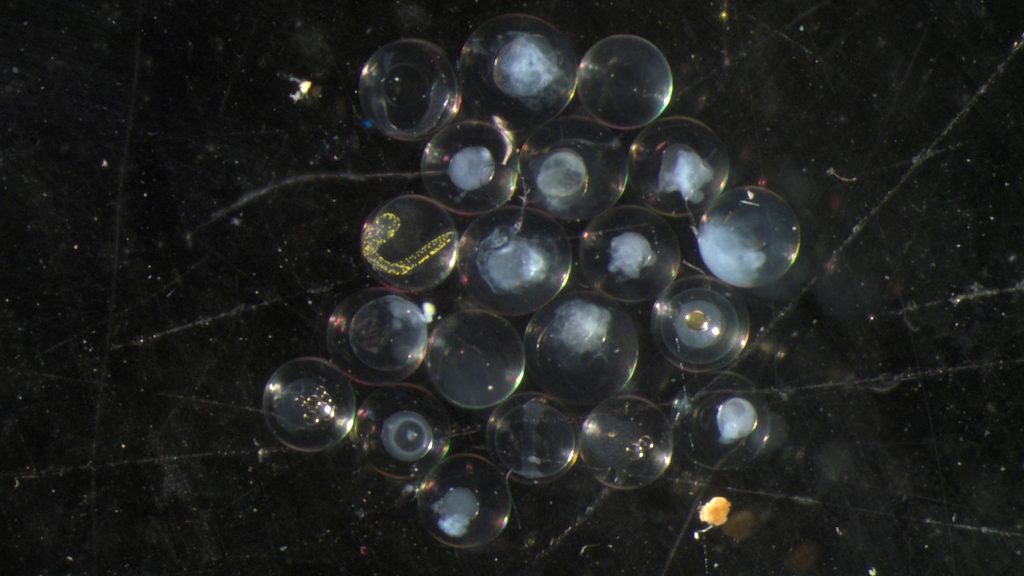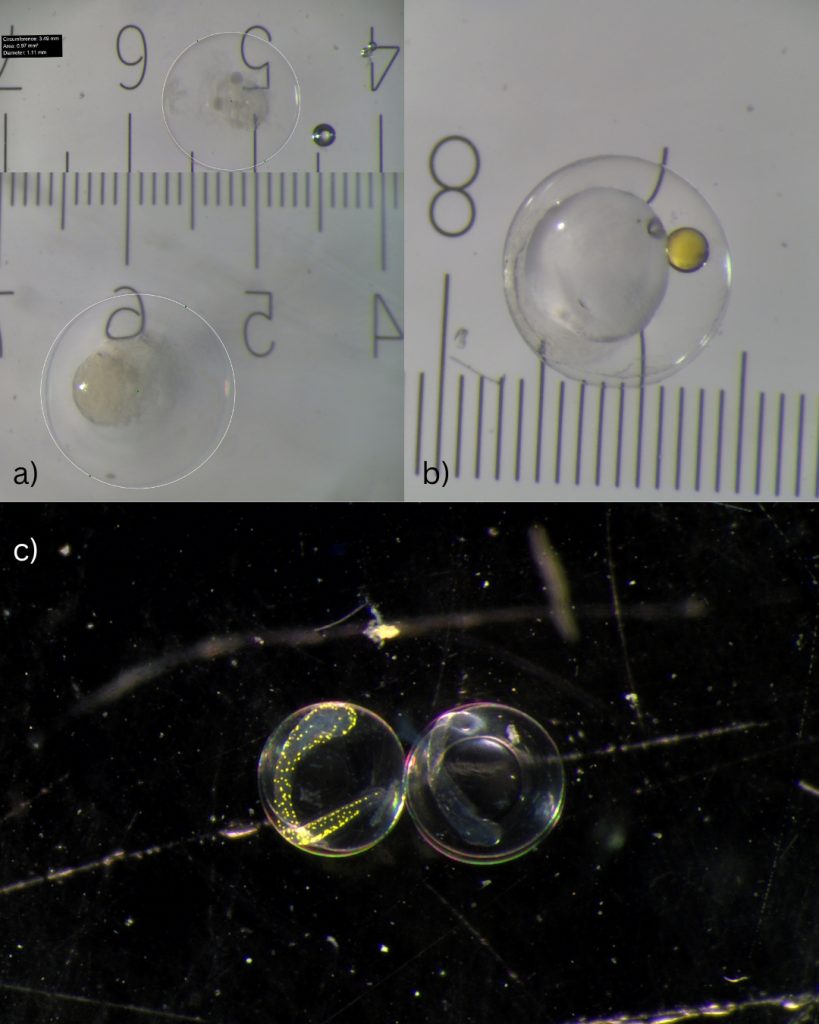Hello again,
I hope you had a nice easter holiday if you are celebrating and that you found time to enjoy spring if you aren’t. For me this year’s easter egg hunt came early and happened onboard of Alkor. Well, at least in some way it did, except that I replaced actual eggs with tiny fish eggs, the hunt in a garden with hours on the binoculars and the basket with test tubes. Follow along as I explain why I did that and what there is to learn about the world of fish eggs!
As you may have read in the post by my colleagues on flatfish, most fish start their lives by hatching from an egg that is either attached to substrate (benthic) or floating freely in the water column (pelagic). These freshly hatched larvae often don’t resemble the adult fish, at all. After having grown up to be of a certain size or age they undergo metamorphosis. After this metamorphosis the fish begins to look a lot more familiar and can be identified with relative ease. While most fish larvae don’t look a lot like their adult stages, they do have enough defining characteristics to be identified as a member of their species. In the species poor Baltic Sea for example, a beginner can identify most fish larvae to at least family level within a couple of hours of practice. Species level identification is also possible but typically requires more training while the correct identification of fish larvae in more diverse areas, such as the tropics, can get complicated really fast.
As you can probably imagine, the species-specific differences are even less pronounced once we get down to the egg level. One would assume that they all look somewhat alike and that their identification could be almost impossible. However, after some time of staring at these little soap bubbles of fishy origin, I found myself surprised by how different they all are! While I am not yet completely confident with my species identifications, I wanted to at least give you an overview of what kind of fish eggs you can expect to find in the Baltic Sea during your next holiday ichthyoplankton survey:

The first thing that can be used to discern the species of eggs is simply by asking, where in the ocean are the eggs from? Some species like cod and the different flatfish, have pelagic eggs that drift with the currents while others lay benthic eggs, that means that they are attached to substrate or plants and don’t drift. As we exclusively used samples obtained from our plankton nets, we already know, that we have sampled the eggs of the pelagic kind.
The second way to differentiate eggs is by their size. This is still very easy to do, as long as you have a stereo microscope available and a (sub-)millimeter scale (Fig. 2a). Beyond this you can use other identifying features along with identification keys to help you identify the species of the eggs that you have sampled. Those differences may include things like the presence or absence of an oil globule in the egg, which is a tiny droplet of oil in the egg can be used for nourishment by the growing larvae and aid buoyancy (i.e., where does the egg float) control (Fig. 2b). In addition, the yolk (yes, even fish eggs have yolks) may be homogeneous, or structured in a variety of ways. Compare the internal structures of the eggs in Fig. 1 if you are curious! Finally, if you are lucky and the larva inside is already well developed, the pigmentation on the larva can give away a lot (Fig 2c).
But why would we even want to sample fish eggs? And why would we go through the trouble of identifying the species? Well, there are multiple good reasons. To gain a full picture of the health of Baltic fish stocks (i.e. understanding how many fish there are of each species) and to understand what impacts them at different life stages it is important to gather data at these stages. By including larvae and eggs in our research we could become better at pinpointing where exactly things are going wrong for a species that is in decline. It could for example be that a species is struggling because something is affecting the survival of eggs into larval stage, or that something is feeding on the larvae more than usual, rather than something that is happening to adults. Without understanding these factors, it is very difficult to implement the right management strategies to improve the state of our ecosystems. In addition, fertilized fish eggs are also a valuable source of genetic material. On one hand, fish eggs are typically more abundant than adult fish and relatively easy to sample. On the other hand, they don’t require the handling and/or harming of a fully grown animal. Also, the comparison of which set of genetic information is present at conception with what information makes it into the adult population could allow us to draw important conclusions about processes like adaptation, evolution and the different kinds of pressures and threats to a fish’s survival.
Personally, I am trying to collect cod eggs because we are interested to see how the cod of the eastern Baltic Sea interact with the ones in the west.
I hope I was able to show you why hunting eggs at sea can be as much fun as hunting Easter eggs!
Noah (member of the scientific crew of AL630
